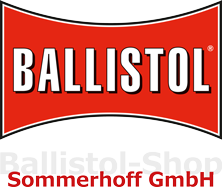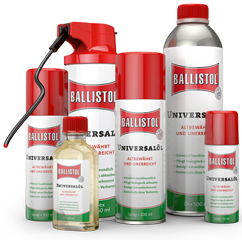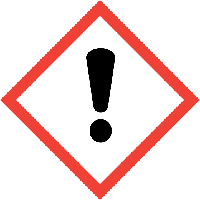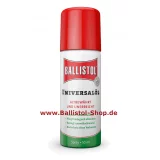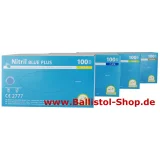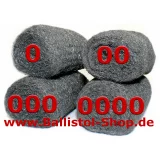Brake Cleaner
-
- Brake cleaner 500 ml spray
- 4,89 EUR*(Groundprice: 9,78 EUR pro Liter)
- Product No.: 25342 / EAN: 4017777253429
- available soon
-
- Brake cleaner 4 x 500 ml spray
- 16,95 EUR*(Groundprice: 8,48 EUR pro Liter)
- Product No.: 25341 / EAN: 4017777253412
- available soon
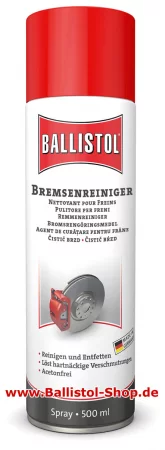
Brake cleaner
Ballistol brake cleaner spray is an effective solvent with a powerful jet. Loose residues, soot and lubricant residues are removed in a flash.
The cleaner is popular for many areas of application because of its easy application with the strong spray jet. The cleaner is used wherever oils and fats or loose deposits need to be removed quickly.
What is brake cleaner used for?
The cleaner with the strong solvent spray jet is used for many areas of application. It is designed for cleaning brakes and parts when assembling brakes or brake parts. When you install new brake pads or brake discs, any remaining lubricant, brake fluid or assembly paste is removed with the brake cleaner. Ultimately, the performance of brake parts must not be reduced by lubricants. The spray therefore has a safety-relevant task.
Application of brake cleaner
- To use, the cleaner can be sprayed directly onto the parts.
- The strong spray jet dissolves fats and rinses off loose particles immediately.
- Depending on how dirty it is, you can also wipe it with a clean tuck if necessary. In this case, apply a final spray and do not wipe again.
Difference between brake cleaner and brake- & parts cleaner
You may have already noticed: brake cleaners range from cheap to expensive. If you don't look closely at the label, you might end up choosing the „wrong“ product.

Ingredients of brake cleaner
Brake cleaner contains a solvent as an active ingredient. There is also a carrier substance and propellant for the spray.
Ingredients of brake- & parts cleaner
Brake- & parts cleaners have cleaning-active substances. With Ballistol these are pleasantly smelling orange terpenes and an alcohol. With a spray, carriers and propellants are also added.
This combination of active ingredients can also be used to dissolve stuck-on residues and organic fats. In the following overview you can assess the differences between the two types of brake cleaner for your purposes. Tip: In hardware stores you can almost always find the „cheap“ version, which is often described as a parts cleaner, which can, however, be a bit misleading. But ultimately these terms are not protected and you have to be careful about what is actually being offered when it comes to particularly cheap offers. Both cleaners have their place. If you mainly want to remove technical grease in the workshop, you don't need the more expensive cleaner.
Overview of advantages and disadvantages and components of brake cleaner
| Brake Cleaner | Brake- and Parts Cleaner | |
|---|---|---|
| Containers | Only as spray spray | Canisters and bulk containers |
| Ingredients | Solvent, carrier substance, propellant | Cleaning active substances, here orange terpenes and alcohol. Only with spray also carrier and propellant. |
| Dissolves organic fats and oils | to a limited extent, may need to be cleaned several times and helped manually | yes |
| Dissolves inorganic fats and oils, such as lubricants and assembly pastes | yes | yes |
| Dissolves stuck residues | no | yes |
| Dissipates quickly | yes, extremely quickly | yes |
| Dissolves tree resins | no | yes |
| Attacks rubber | yes | no |
The cleaner is well suited for degreasing. As you can see in the overview, the simple brake cleaner is more suitable for removing technical lubricants. The parts cleaner can also dissolve organic fats and oils as well as resins.
Because this parts cleaner also evaporates completely at the molecular level and, in the physical sense, evaporates without leaving any residue, the Ballistol brake cleaner is also suitable for pre-treating surfaces for painting, bluing, sealing or bonding.
Overview of all Ballistol brake cleaners
- 500 ml or 4 x 500 ml pack brake cleaner spray
- 500 ml brake and parts cleaner
- 5 liter canister of brake and parts cleaner
- 200 liter barrel of brake and parts cleaner
Technical characteristics
- Appearance: colorless, clear
- Odor: solvent, characteristic
Contents: 500 ml or professional pack 4 x 500 ml = 2 liters at a special price
Details zur Produktsicherheit
Verantwortlicher Wirtschaftsakteur gemäß EU-Verordnung:F.W. Klever GmbH
Hauptstraße 20
84168
Deutschland
info@ballistol.de
Kennzeichnung gemäß Verordnung (EG) Nr. 1272/2008 [CLP/GHS]
- Signalwort: Gefahr
- Gefahrenhinweise für Gesundheitsgefahren
- H222 Extrem entzündbares Aerosol.
- H229 Behälter steht unter Druck: Kann bei Erwärmung bersten.
- H315 Verursacht Hautreizungen.
- H336 Kann Schläfrigkeit und Benommenheit verursachen.
- H411 Giftig für Wasserorganismen, mit langfristiger Wirkung.
- Sicherheitshinweise
- Allgemeines
- P102 Darf nicht in die Hände von Kindern gelangen.
- Prävention
- P210 Von Hitze, heißen Oberflächen, Funken, offenen Flammen sowie anderen Zündquellenarten fernhalten. Nicht rauchen.
- P211 Nicht gegen offene Flamme oder andere Zündquelle sprühen
- P251 Nicht durchstechen oder verbrennen, auch nicht nach Gebrauch.
- P261 Einatmen von Staub / Rauch / Gas / Nebel / Dampf / Aerosol vermeiden.
- P264 Nach Gebrauch Hände gründlich waschen.
- P271 Nur im Freien oder in gut belüfteten Räumen verwenden.
- P273 Freisetzung in die Umwelt vermeiden.
- P280 Schutzhandschuhe / Schutzkleidung / Augenschutz / Gesichtsschutz tragen.
- Reaktion
- P301 + P310 BEI VERSCHLUCKEN: Sofort GIFTINFORMATIONSZENTRUM / Arzt /… anrufen.
- P302 + P352 BEI BERÜHRUNG MIT DER HAUT: Mit viel Wasser /… waschen.
- P304 + P340 BEI EINATMEN: Die Person an die frische Luft bringen und für ungehinderte Atmung sorgen.
- P312 Bei Unwohlsein GIFTINFORMATIONSZENTRUM / Arzt / … anrufen.
- P321 Besondere Behandlung (siehe … auf diesem Kennzeichnungsetikett).
- P331 KEIN Erbrechen herbeiführen.
- P332 + P313 Bei Hautreizung: Ärztlichen Rat einholen / Ärztliche Hilfe hinzuziehen.
- P362 + P364 Kontaminierte Kleidung ausziehen und vor erneutem Tragen waschen.
- P391 Verschüttete Mengen aufnehmen.
- Lagerung
- P403 + P233 An einem gut belüfteten Ort aufbewahren. Behälter dicht verschlossen halten.
- P405 Unter Verschluss aufbewahren.
- P410 + P412 Vor Sonnenbestrahlung schützen. Nicht Temperaturen über 50 °C/122 °F aussetzen
- Entsorgung
- P501 Inhalt / Behälter der Entsorgung gemäß den örtlichen / nationalen / internationalen Vorschriften zuführen.
